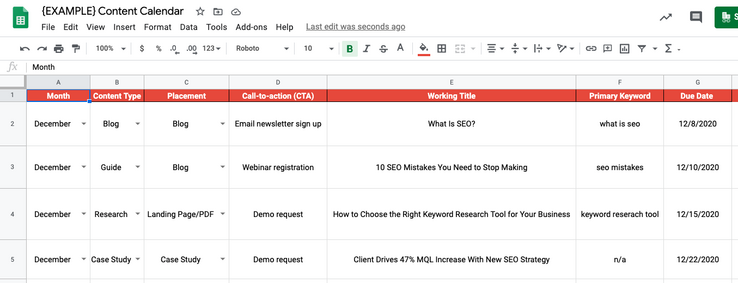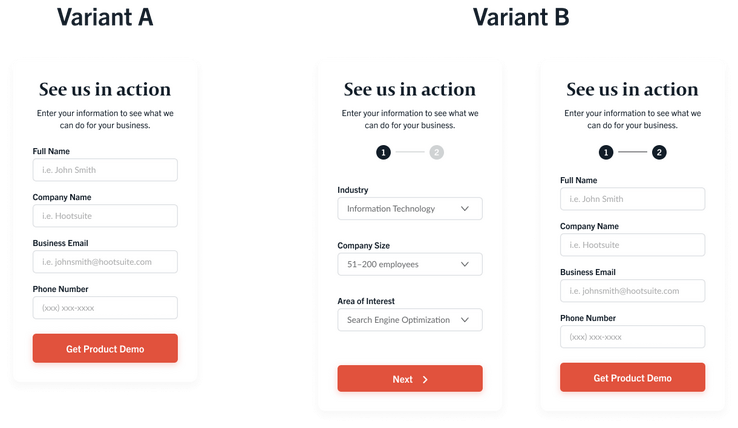Posted by IzabelleHundrev
If there’s one thing that most marketers have in common, it’s that we want more leads.
Sure, not all leads are good. Some are even downright unqualified. But leads are what drive business, and as a result, many of us are held accountable for generating more of them.
Out of all of the lead generation strategies out there, there’s one that I find particularly effective: search engine optimization (SEO) and conversion rate optimization (CRO) working together.
While this may seem obvious, you’d be surprised how many marketing teams are really good at one or the other, but fail to find the balance between both.
Below, I’ll share why it’s critical to find alignment between SEO and CRO, and how to do it so that both of these functions work together to drive qualified leads for your business.
SEO and CRO: Why you can’t have one without the other
Being discoverable is more important than it’s ever been. If a prospective buyer can’t find your business online, there’s a good chance that you’re leading them right into the arms of your competitors.
By now, most businesses understand the importance of having a presence in organic search results. SEO is more than just a buzzword, it’s a given. And it’s critical to growing brand awareness and driving traffic to your website.
But there’s a catch.
Traffic doesn’t magically turn into paying customers and revenue. Ask yourself, when someone clicks on an organic result and lands on your website, what kind of browsing experience are they having? Is your site easy to navigate? Are your web pages optimized to guide the user towards an action?
Traffic without conversions is essentially just a vanity metric. CRO is the piece that ties it all together.
Put simply, conversion rate optimization is the process of optimizing a web page to lead a user toward a desired action. Typically, this action comes in the form of a conversion. This can be a demo request, email newsletter sign up, webinar registration — you get the gist.
The idea here is to entice the user to move further down the marketing funnel in some way.
SEO is what brings people to your website and CRO is what gets them to convert.
It sounds like a match made in marketing heaven, but achieving alignment is often easier said than done.
Start with a strong SEO foundation
I could write thousands of words on what it takes to build a strong SEO foundation for your website, but that’s not what this article is about. With that being said, a discussion about the relationship between SEO and CRO wouldn’t be complete without a mention of it.
Earlier, I said you can’t have SEO without CRO. But this goes both ways.
While it’s true that conversions are a meaningful standalone metric, you can’t have conversions without web visitors. Plus, experimentation and testing is a big part of what makes CRO so effective. It can be difficult to run tests if your website doesn’t get a healthy amount of traffic. More on this later.
A successful SEO strategy fuels the inbound marketing engine to bring new prospective buyers to your site on a regular basis. With SEO, your entire marketing team could be on PTO for a week and your website will still be generating traffic on its own.
If you’re still working to build a powerful SEO strategy, there are countless SEO resources that are available to you.
Be intentional about your content
Content and SEO go hand-in-hand.
When a buyer goes to a search engine, they want to find content that brings them an answer to their question.
As marketers, we want to create that content and match it to a buyer’s specific search query. We do this through extensive keyword research and on-page optimization to ensure that every piece of content that’s published has a likelihood to rank on page one.
Although this approach to content creation is effective at generating organic traffic, sometimes we forget to think about how a piece can drive impact beyond just ranking number one for a keyword.
CRO doesn’t just apply to landing pages or core solutions pages. There are elements of CRO that apply to your long-from content as well.
When strategizing topic ideas and doing keyword research, assign a goal to every piece of content that you publish. Ask yourself, “what action do I want the reader to take when they land on this page?”
Build this goal into your content calendar and incorporate it as a call-to-action (CTA) on each page that you publish.

As always, be mindful of the reader and their position in the funnel. Someone that lands on “The Beginner’s Guide to Marketing Automation” probably isn’t ready for a live demo just yet.
Instead, guide that reader toward a less intimidating action, such as signing up for your email newsletter. A good CTA shouldn’t feel spammy or overly promotional, it should provide additional value to the reader overall.
Following this process forces you to think beyond just traffic — you’re focusing on conversions before you even hit the “publish” button.
Test, optimize, and repeat
User experience (UX) is at the heart of both SEO and CRO.
If your website is slow, glitchy, and hard to navigate, it’s going to negatively affect both traffic and conversions. The goal is to continuously refine your website to ensure that anyone who lands on it has a frictionless browsing experience — thereby increasing their likelihood to convert.
This is why split testing is so important.
Split testing, sometimes referred to as A/B testing, is the process of testing multiple variants of a web page to determine which one converts at a higher rate. This is a core practice among marketers who specialize in CRO. You can test different types of lead forms, CTA buttons, copy variants, and even page layouts.
Here’s an example of a split test between a single and multi-step lead form:

Some SEOs may be hesitant to run split tests because they worry it will negatively affect organic rankings. The truth is that Google not only encourages testing, but it even has its own tool that helps marketers to run split tests.
As long as you’re abiding by Google’s webmaster guidelines, you should see no major negative impact on organic traffic due to testing.
It’s also worth noting that you can’t reach statistical significance in your split tests without a big enough sample size. In other words, you need traffic to have accurate test results.
There’s no hard and fast rule for what counts as “enough traffic” but the general consensus is that your web visitors should be in the thousands, at least. I recommend using this sample size calculator tool to get a better idea of a number that’s unique to your website.
This is yet another example of how closely intertwined SEO and CRO truly are. Earlier we discussed how important it is to start with a solid foundation in SEO, now you know how it fits into the bigger picture.
The common thread here?
CRO and SEO have a symbiotic relationship. What’s good for one is good for the other. And both are working toward the same common goal of generating revenue.
Identify marketing funnel gaps
When looking at the big picture of your inbound marketing efforts, SEO and CRO can help you identify and fix any gaps in your funnel.
Let’s say you have a product page that ranks #1 for its primary keyword and generates lots of traffic. But, when you dig into the conversion data, you notice that only a small percentage of users that land on that page actually convert.
This is a red flag that something is off with the page.
It could be the messaging, the offer, or the lead form. Just because it works for Google doesn’t mean it’s working for your audience. And their opinion is the only one that matters.
This goes the other way around too.
Say you have a product page that’s converting at a high rate, but you notice that it’s one of the lowest-trafficked pages on your site. This should alert you to revisit the content on that page and identify opportunities to re-optimize it. If you don’t, there are likely hundreds of potential conversions that you’re missing out on.
Final thoughts
SEO and CRO is kind of like the digital marketing version of the chicken and the egg. You can’t be really good at one without the other.
Realistically, it doesn’t matter what came first. What does matter is achieving alignment between these two key marketing tactics. By doing so, your website has the potential to become a major driver of leads and revenue for your business.
If there’s one thing you take away from this article, it’s to integrate your SEO and CRO efforts and view them as one cohesive part of your lead generation strategy.
Sign up for The Moz Top 10, a semimonthly mailer updating you on the top ten hottest pieces of SEO news, tips, and rad links uncovered by the Moz team. Think of it as your exclusive digest of stuff you don't have time to hunt down but want to read!
![]()


Recent Comments